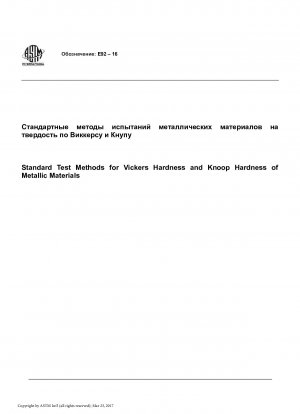ASTM E92-16
Standard Test Methods for Vickers Hardness and Knoop Hardness of Metallic Materials
- Standard No.
- ASTM E92-16
- Release Date
- 2016
- Published By
- American Society for Testing and Materials (ASTM)
- Status
- Replace By
- ASTM E92-17
- Latest
- ASTM E92-23
- Scope
4.1 Vickers and Knoop hardness tests have been found to be very useful for materials evaluation, quality control of manufacturing processes and research and development efforts. Hardness, although empirical in nature, can be correlated to tensile strength for many metals, and is an indicator of wear resistance and ductility.
4.2 Microindentation hardness tests extend testing to materials that are too thin or too small for macroindentation hardness tests. Microindentation hardness tests also allow specific phases or constituents and regions or gradients too small for macroindentation hardness testing to be evaluated. Recommendations for microindentation testing can be found in Test Method E384.
4.3 Because the Vickers and Knoop hardness will reveal hardness variations that may exist within a material, a single test value may not be representative of the bulk hardness.
4.4 The Vickers indenter usually produces essentially the same hardness number at all test forces when testing homogeneous material, except for tests using very low forces (below 25 gf) or for indentations with diagonals smaller than about 25 µm (see Test Method E384). For isotropic materials, the two diagonals of a Vickers indentation are equal in length.
4.5 The Knoop indenter usually produces similar hardness numbers over a wide range of test forces, but the numbers tend to rise as the test force is decreased. This rise in hardness number with lower test forces is often more significant when testing higher hardness materials, and is increasingly more significant when using test forces below 50 gf (see Test Method E384).
4.6 The elongated four-sided rhombohedral shape of the Knoop indenter, where the length of the long diagonal is 7.114 times greater than the short diagonal, produces narrower and shallower indentations than the square-based pyramid Vickers indenter under identical test conditions. Hence, the Knoop hardness test is very useful for evaluating hardness gradients since Knoop indentations can be made closer together than Vickers indentations by orienting the Knoop indentations with the short diagonals in the direction of the hardness gradient.
1.1 These test methods cover the determination of the Vickers hardness and Knoop hardness of metallic materials by the Vickers and Knoop indentation hardness principles. This standard provides the requirements for Vickers and Knoop hardness machines and the procedures for performing Vickers and Knoop hardness tests.
1.2 This standard includes additional requirements in annexes:
Verification of Vickers and Knoop Hardness Testing Machines
A......
ASTM E92-16 Referenced Document
- ASTM C1326 Standard Test Method for Knoop Indentation Hardness of Advanced Ceramics
- ASTM C1327 Standard Test Method for Vickers Indentation Hardness of Advanced Ceramics
- ASTM E140 Standard Hardness Conversion Tables for Metals Relationship Among Brinell Hardness, Vickers Hardness, Rockwell Hardness, Superficial Hardness, Knoop Hardness, and Scleroscope Hardness
- ASTM E175 Standard Terminology of Microscopy
- ASTM E177 Standard Practice for Use of the Terms Precision and Bias in ASTM Test Methods
- ASTM E29 Standard Practice for Using Significant Digits in Test Data to Determine Conformance with Specifications
- ASTM E3 Standard Practice for Preparation of Metallographic Specimens
- ASTM E384 Standard Test Method for Microindentation Hardness of Materials
- ASTM E6 Standard Terminology Relating to Methods of Mechanical Testing
- ASTM E691 Standard Practice for Conducting an Interlaboratory Study to Determine the Precision of a Test Method
- ASTM E7 Standard Terminology Relating to Metallography
- ASTM E74 Standard Practices for Calibration and Verification for Force-Measuring Instruments
- ISO 6507-1 Metallic materials — Vickers hardness test — Part 1: Test method
- ISO/IEC 17011 Conformity assessment — Requirements for accreditation bodies accrediting conformity assessment bodies*, 2024-04-20 Update
- ISO/IEC 17025 General requirements for the competence of testing and calibration laboratories [Standard in French]
ASTM E92-16 history
- 2023 ASTM E92-23 Standard Test Methods for Vickers Hardness and Knoop Hardness of Metallic Materials
- 2017 ASTM E92-17 Standard Test Methods for Vickers Hardness and Knoop Hardness of Metallic Materials
- 2016 ASTM E92-16 Standard Test Methods for Vickers Hardness and Knoop Hardness of Metallic Materials
- 1982 ASTM E92-82(2003)e2 Standard Test Method for Vickers Hardness of Metallic Materials
- 1982 ASTM E92-82(2003)e1 Standard Test Method for Vickers Hardness of Metallic Materials
- 2003 ASTM E92-82(2003) Standard Test Method for Vickers Hardness of Metallic Materials
- 1997 ASTM E92-82(1997)e3 Standard Test Method for Vickers Hardness of Metallic Materials

Copyright ©2024 All Rights Reserved